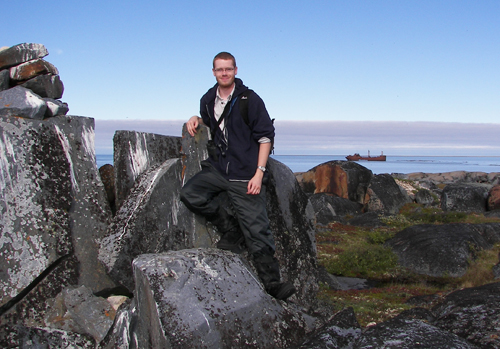
Today he’s an expert in DNA barcoding of birds. But he got his start by throwing a childhood tantrum in a bookstore.
“My parents tell me I was about four,” says Kevin Kerr, speaking over the phone early this summer from the Smithsonian Institution in Washington, D.C. “My dad says I picked up a bird book in the store and threw a tantrum. They bought the book.”
Kerr has been a birder ever since. Besides using books and binoculars in the field, the two-time U of G graduate has become an authority in the lab in using genetics to identify avian species.
During a post-doc at the Smithsonian’s National Museum of Natural History that ended this past summer, he worked with scientists in the feather identification lab. The bird strike program run there by Kerr’s supervisor – program manager Carla Dove – is intended to improve air safety, protecting both people and birds.
Every year, bird and other wildlife strikes cause hundreds of millions of dollars’ worth of damage and endanger human lives, according to the volunteer Bird Strike Committee USA.
Although a few species are frequent culprits – including horned larks and Canada geese – it’s often difficult to tell which birds are involved in incidents. It was the Smithsonian group that helped figure out what caused a passenger jet to ditch in New York’s Hudson River in 2009. Several people were injured but no one died in the incident, dubbed the “miracle on the Hudson.” DNA barcoding of bird remains in the disabled engines confirmed that the plane had struck a flock of Canada geese shortly after takeoff.
Kerr wasn’t involved in investigating that particular incident; he arrived at the Smithsonian after completing his doctorate in 2010. But, he says, “The DNA barcodes for the unknown geese were matched up with reference sequences that we produced at U of G as part of a 2007 study on North American birds and a yet-unpublished study on Canada geese.”
While at the Smithsonian, Kerr helped conduct molecular work on samples, called “snarge,” under the bird strike program. “Based on morphology and using the Smithsonian collection, they can compare samples to voucher specimens and often get the exact species with only feathers,” says Kerr. “But sometimes it’s only a smear across an engine, and in those cases we use the barcode library.”
That barcode library is held at Guelph’s Biodiversity Institute of Ontario (BIO), where scientists help lead global programs intended to catalogue all organisms using a telltale bit of their genetic material.
DNA barcoding to distinguish between species of living things was developed by U of G’s Prof. Paul Hebert, Integrative Biology. Kerr entered many of the avian specimens in that BIO collection while working on his doctorate with Hebert.
Kerr plans to attend a North American conference next week fall in Ontario, including a joint meeting of the American volunteer group and the Bird Strike Association of Canada. He’s just begun a two-year post-doc in the natural history department of the Royal Ontario Museum. Working with Allan Baker, senior curator of ornithology, Kerr is studying genome evolution to learn more about how birds perform high-energy tasks such as long flights and dives.
For his barcoding work, he has looked at birds from museum collections in North America and across northern Asia. He’s done field work in Argentina and taught molecular methods to visiting students at BIO through the Argentine Museum of Natural Sciences.
While at Guelph, he co-authored a 2007 paper with Hebert and Dove on DNA barcoding of North American birds. He also worked with the Canadian Wildlife Service on a barcoding study of the Canada goose and the cackling goose, formerly considered a subspecies of the Canadian icon. That molecular work verified a decision by the American Ornithologists’ Union to separate the species, which had previously been classified together.
Kerr still has that childhood birding guide among numerous volumes at home. Also in his collection is an autographed copy of The Life of Birds by British naturalist and film-maker David Attenborough, who received an honorary doctorate from Guelph during the third year of Kerr’s undergrad here.

Kerr had applied to several universities but chose Guelph for its wildlife focus. He grew up in Scarborough, Ont., where he often went bird-watching in the hydro corridor behind the house. He can ID hundreds of species by sight or sound and has logged almost 1,000 different kinds. He’s taken his binoculars and field guides to spots ranging from Long Point on Lake Erie to both Australia and the Arctic during U of G ecology field courses.
Among his favourite outings was a teenage trip with his dad to Arizona. Their highlight was spotting a male elegant trogon with its “brilliant green top and red belly and an odd call like a pig oinking.” Kerr hopes to return one day to look for a missed spotted owl. Back in Washington this summer, he managed to spot another longtime nemesis – the Louisiana waterthrush – that had eluded him for years.
And now back in Ontario, he’s collected a copy of a painting of a snowy egret – a belated graduation gift from his parents. Apparently they’ve forgiven him for that long-ago tantrum.